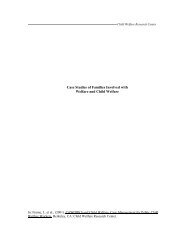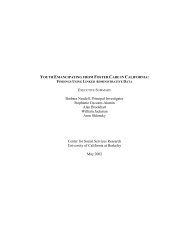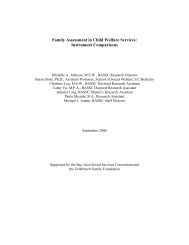Developing a Self-Assessment Toolfor Culturally - Office of Minority ...
Developing a Self-Assessment Toolfor Culturally - Office of Minority ...
Developing a Self-Assessment Toolfor Culturally - Office of Minority ...
Create successful ePaper yourself
Turn your PDF publications into a flip-book with our unique Google optimized e-Paper software.
the study, including information on options for accessing and completing the questionnaire,through electronic mail, Internet web site, facsimile, or postal mail.4. Develop an alternate contact letter for sending two follow-up questionnaires to oneindividual staff member (to distribute to others in the organization). On one occasion during thepilot, the senior executive requested to recommend only one individual to receive theinformation for both the Staffing and Membership Questionnaires. This single designee was toreceive the contact materials and then distribute the two questionnaires to the appropriate staff inthe organization. To accommodate these unforseen circumstances, a third (alternate) contactletter from OMH was developed to use under these conditions.The final data collection methodology that resulted from information learned through theliterature review; discussions and deliberations among the research team, OMH staff, and thetwo advisory groups; and the pilot administration, is presented in Exhibit 2.2.2 Incorporating Efforts to Maximize Response Rate and Reduce RespondentBurdenBecause <strong>of</strong> the changing landscape <strong>of</strong> the health care system at that time, as well as theirconcerns about obtaining a high response rate, members <strong>of</strong> the expert panel advised the researchteam and OMH staff that obtaining the needed sample size <strong>of</strong> 240 MCOs would be difficult atbest. With this caution, a significant attempt was made to anticipate reasons for non-responseand incorporate strategies for increasing response rate into the data collection design prior togoing into the field. The initial strategies that were included in the original data collection planare described below. Additional strategies to increase response rate were utilized after the actualdata collection process started.Sample Over-recruitment. To ensure an adequate sample size and account for attrition, theinitial sample <strong>of</strong> MCOs was over-recruited from the universe <strong>of</strong> MCOs. The original studysample size was 240, but an over-sampling strategy was employed prior to sample selection toincrease the sample size by 20 percent (48 additional organizations).Respondent Contact Materials and Protocols Provide Clear Descriptions <strong>of</strong> the Study, itsPurpose, and its Importance. To stress the study’s importance, a formal introductory lettersigned by the Deputy Assistant Secretary for <strong>Minority</strong> Health would be mailed to all identifiedsenior executives <strong>of</strong> MCOs selected for study participation. The letter would announce anddescribe the study, its purpose, and its importance. Several enclosures would accompany theletter to emphasize the credibility <strong>of</strong> the study. The enclosures would include: 1) a letter from asenior representative <strong>of</strong> AAHP stating the organization’s support for the study and encouragingparticipation <strong>of</strong> each MCO; and 2) membership lists <strong>of</strong> the study’s two advisory committees. Allmaterials to be received by respondents (including questionnaires, letters, and postcards), wouldprovide assurance <strong>of</strong> confidentiality and anonymity. Also, respondents would be assured datawould be reported as aggregated summaries without individual or organizational identification.COSMOS Corporation, December 2003 G-7
















